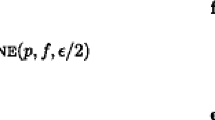Abstract
The performance of maximum-flow algoirthms that work in phases is studied as a function of the maximum arc capacity,C, of the network and a quantity we call thetotal potential, P, of the network, which is related to the average amount of flow that can be sent through a node. Extending results by Even and Tarjan, we derive a tightO(min{C 1/3¦V¦2/3,P 1/2, ¦V¦}) upper bound on the number of phases. AnO(min{P log¦V¦,C¦V¦3/2, ¦V¦2¦E¦}) upper bound is derived on the total length of the augmenting paths used by Dinic's algorithm. The latter quantity is useful in estimating the performance of Dinic's method on certain inputs. Our results show that on a natural class of networks, the performance of Dinic's algorithm is significantly better than would be apparent from a bound based on ¦V¦ and ¦E¦ alone. We present an application of our bounds to the maximum subgraph density problem.
Similar content being viewed by others
References
Cherkaski, B. Algorithm for construction of maximal flow in networks with complexityO(¦V¦2¦E¦1/2) operations.Math. Methods Solutions Econ. Problems 7 (1977), 117–125 (in Russian—see also [GALI80]).
Cheung, T. Computational comparison of eight methods for the maximum flow problem.ACM Trans. Math. Software 6 (1980), 1–16.
Dinic, E. A. Algorithm for solution of a problem of maximum flow in a network with power estimation.Soviet Math. Dokl. 11 (1970), 1277–1280.
Even, S., and Tarjan, R. E. Network flow and testing graph connectivity.SIAM J. Comput. 4 (1975), 507–518.
Fernández-Baca, D. Improved Bounds on Network Flow Algorithms with Applications. Ph.D. Dissertation, Computer Science Division, University of California, Davis, CA, 1986.
Gabow, H. N. Scaling algorithms for network problems.Proceedings of the 24th Annual IEEE Symposium on Foundations of Computer Science, 1983, pp. 248–257.
Galil, Z. AnO(V 5/3 E 2/3) algorithm for the maximal flow problem.Acta Inform. 14 (1980), 221–242.
Galil, Z., and Naamad, A. AnO(EV log2 V) algorithm for the maximal flow problem.J. Comput. System Sci. 21 (1980), 203–217.
Gallo, G., Grigoriades, M., and Tarjan, R. A fast parametric minimum cut algorithm. Technical Report LCSR-TR-95, Department of Computer Science, Rutgers University, New Brunswick, NJ, November 1986.
Gusfield, D., Martel, C. U., and Fernández-Baca, D. Fast algorithms for bipartite network flow.SIAM J. Comput. 16 (1987), 237–251.
Goldberg, A. V. Dfficient Algorithms for Sequential and Parallel Computers. Ph.D. Dissertation, EECSS Department, Massachusetts Institute of Technology, Cambridge, MA, January 1987.
Goldberg, A. V., and Tarjan, R. E. A new approach to the maximum flow problem.Proceedings of the 18th Annual ACM Symposium on Theory of Computing, 1986, pp. 136–146.
Karzanov, A. V. Determining the maximal flow in a network by the method of preflows.Soviet Math. Dokl. 15 (1974), 434–437.
Martel, C. U. A Comparison of Phase and Non-Phase Network Flow Algorithms. Technical Report CSE-87-7, Computer Science Division, University of California, Davis, CA, June 1987.
Malhotra, V., Pramod Kumar, M., and Maheshwari, S. AnO(¦V¦3) algorithm for finding maximum flows in networks.Inform. Process. Lett. 7 (1978), 277–278.
Papadimitriou, C. H., and Steiglitz, K.Combinatorial Optimization: Algorithms and Complexity. Prentice-Hall, Englewood Cliffs, NJ, 1982.
Picard, J., and Queyranne, M. Selected Applications of Minimum Cuts in Networks.INFOR 20 (1982), 394–422.
Picard, J., and Queyranne, M. A network flow solution to some non-linear 0-1 programming problems with applications to graph theory.Networks 12 (1982), 141–159.
Sleator, D. D., and Tarjan, R. E. A data structure for dynamic trees.J. Comput. System Sci. 26 (1983), 362–391.
Tarjan, R. E.Data Structures and Network Algorithms. Society for Industrial and Applied Mathematics, Philadelphia, PA, 1983.
Author information
Authors and Affiliations
Additional information
Communicated by Nimrod Megiddo.
Rights and permissions
About this article
Cite this article
Fernández-Baca, D., Martel, C.U. On the efficiency of maximum-flow algorithms on networks with small integer capacities. Algorithmica 4, 173–189 (1989). https://doi.org/10.1007/BF01553885
Received:
Issue Date:
DOI: https://doi.org/10.1007/BF01553885




